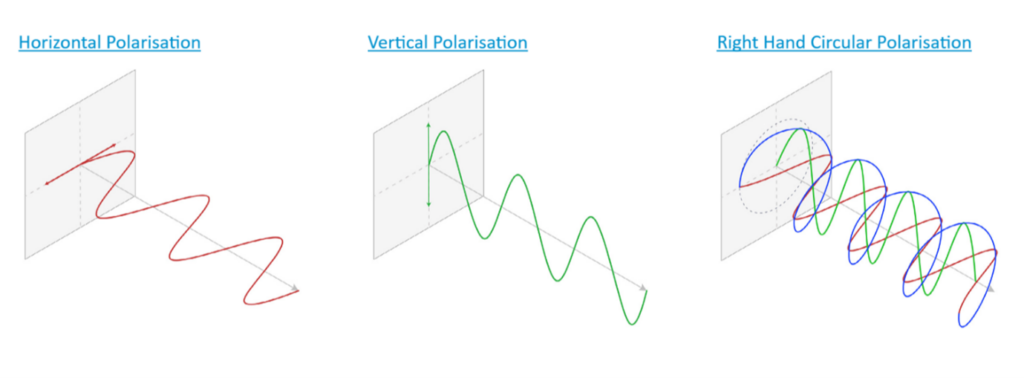When your antenna has a clear line of sight, you’d expect excellent signal strength. But if performance is underwhelming, it might not be down to range or interference—it could simply be the wrong antenna polarization.
Polarization is a critical factor in RF antenna performance, especially in applications like GNSS, LTE/5G, LoRa, or Wi-Fi. In this guide, we’ll explain what antenna polarization is, why it matters, and how to match it correctly for your application.
What Is Antenna Polarization?
Antenna polarization refers to the orientation of the electric field of a radio wave as it travels through space. It defines how the electromagnetic wave is emitted or received by the antenna.
There are three types of polarization:
- Linear Polarization: The electric field oscillates in a straight line—either vertically or horizontally.
- Circular Polarization: The electric and magnetic fields rotate in a helical pattern. It can be RHCP (Right Hand Circular Polarization) or LHCP (Left Hand).
- Elliptical Polarization: A combination of linear and circular, forming an ellipse due to uneven amplitudes.

Why Polarization Matching Is Essential
Antennas work in pairs—transmitting and receiving. For maximum efficiency, their RF polarization must align. If one antenna is vertically polarized and the other is horizontal, signal strength may drop to near zero.
That’s because the electric fields are orthogonal, and the receiving antenna effectively “can’t see” the wave. This problem is surprisingly common in IoT, telemetry, and field-deployed systems.
Circularly polarized antennas help in scenarios where reflections, rotations, or shifting orientations can’t be avoided—like in satellite or drone communications.
Where Antenna Polarization Really Matters
Matching antenna polarization isn’t optional in these use cases—it’s critical to performance:
- GNSS (GPS, Galileo, GLONASS, BeiDou): Requires RHCP antennas to match the satellite signal.
- Cellular (GSM/UMTS/LTE/5G): Typically uses vertical linear polarization on base stations.
- LoRa and Sigfox: Also benefit from vertical polarization, especially in long-range applications.
- Wi-Fi and Bluetooth: Often use vertical or horizontal polarization depending on the device orientation.
- Satellite links: Use circular polarization to avoid signal degradation from movement or weather.

Modern Car GPS Antenna Installed on Vehicle Roofs.
How to Check Antenna Polarization in Siretta Products
Every Siretta antenna datasheet clearly lists the polarization under the Electrical Specifications section. Whether you’re choosing a vertically polarized cellular antenna or an RHCP GNSS model, you’ll find this vital info there.
We also include an orientation diagram in every datasheet, showing the antenna’s X, Y, and Z axes—so you can mount it correctly for optimal polarization alignment.
If you’re ever in doubt, our team is happy to help you confirm the correct antenna for your use case.
Tips to Avoid Polarization Pitfalls
- Don’t mix vertical and horizontal polarizations unless you’re using dual-polarized antennas.
- Don’t assume omnidirectional means omni-polarized—most still radiate in a specific polarization.
- Check for RHCP when selecting GNSS antennas.
- Look out for reflected signals in urban settings—circular polarization can help reduce interference.
Quick Guide: How to Match Antenna Polarization
- Check the datasheet → Look for “Polarization” in Electrical Specs.
- Check the application → GNSS = RHCP, LTE = Vertical Linear.
- Check the orientation diagram → Align the Z-axis correctly.
- Test if needed → Use tools like the Siretta SNYPER to optimize field performance.
Frequently Asked Questions
What happens if antenna polarization is mismatched?
Signal strength drops—often drastically. In some cases, nearly all signal energy is lost.
Is circular polarization better than linear?
It depends. Circular polarization is ideal where the antenna orientation may vary or reflect—such as with GNSS or satellite links.
How do I find out what polarization an antenna has?
Check the antenna’s datasheet. All Siretta datasheets clearly list the polarization type in the electrical specifications section.
Can I rotate a linearly polarized antenna without affecting performance?
No. Rotating a vertically polarized antenna to horizontal (or vice versa) can significantly reduce signal strength.
Don’t Let Polarization Undermine Your RF Design
Choosing the wrong polarization isn’t just a technical hiccup—it’s a performance killer. Make sure your antenna is aligned with your application, frequency, and environment.
✅ Check the datasheet
✅ Use the right polarization
✅ Match your antenna to the job
Browse Siretta’s Antenna Range here.

